 |
Raoul
Wallenberg: A Hero For Our Time
By Rachel Oestreicher Bernheim, 1981
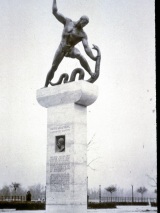
A monument to Raoul Wallenberg
by the Hungarian Sculptor |
Prologue
In Tribute
In
these dark and cynical times, when there is so very little
for mankind to believe in, when the historian and the investigative
reporter have trained us to expect the worst of the great,
it is little wonder that the world does not quite know what
to make of Raoul Wallenberg - or that too many governments
have chosen to maintain a shameful silence.
Sadly,
noble words are robbed of their meaning. We hear him called
"righteous Gentile," "hero of the Holocaust,"
"unsung martyr of World War II." Now and then
some scholar addresses himself anew to the question of how
and by what means Wallenberg managed to save one hundred
thousand lives, or probes the psychosocial impulses which
compelled him to forsake wealth and ease and undertake so
dangerous a mission.
But
when we have set down the last pious platitude, made our
tallies and pondered his motives, something in Raoul Wallenberg
still eludes us. He remains a mystery, as do all pure-souled,
whole-hearted, thoroughly moral men. We are left only with
the everlasting memory of what he did - and what Raoul Wallenberg
did was to fulfill, as none in his time would or could,
the terms of the contract which binds each of us to humanity.
The Talmud summed up that contract in these words: "Whoever
saves a single soul, it is as if he saved the whole world."
Therefore
we must do more than cling to his memory. We must proclaim
to all the nations that Raoul Wallenberg lives, tirelessly
champion his cause, tirelessly press for news of his fate
- till the day, if it please God, that Raoul Wallenberg
returns to us from the long, bitter totalitarian night.
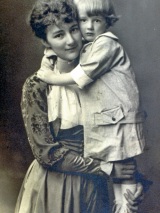
Raoul,
aged 3, with his widowed mother, Maj Wising. |
Raoul
Wallenberg was born August 4, 1912. His parents
came from two of Sweden's most outstanding families, whose
members included diplomats, bankers, and bishops of the
Lutheran Church, as well as artists and professors.
Wallenberg's birth was surrounded by tragedy. His handsome
father (after whom he was named), an officer in the Swedish
Navy and the sone of the Swedish ambassador to Japan, died
after a brief illness at the age of 23 - eight months after
his marriage and three months before the birth of his son.

Raoul Wallenberg
senior aged 23 |
Raoul's mother, Maj Wising Wallenberg, was only 21 at the
time. Three months after Raoul's birth, his grandfather
Wising died suddenly of pneumonia. Many years later, Nina
Lagergren, Raoul's half-sister said, "All
of a sudden, in that once-happy house, there were two widows
and this baby boy." The two bereaved women focused
all of their love on the child who, says Nina Lagergren,
"gave and received so much love that he grew up to
be an unusually generous, loving, and compassionate person."
In 1918, Maj Wallenberg remarried. Her second husband, Fredrik
von Dardel, was a young civil servant in the health ministry.
He later became the administrator of Karolinska, Sweden's
largest hospital, world famous for its medical research.
Two more children were born to Maj von Dardel, Guy and Nina.
Both serve as leaders of the international Raoul Wallenberg
effort.
This is page 8: Has a different picture to add
Ambassador Gustav Wallenberg, Raoul's grandfather, insisted
that Raoul receive an education befitting a member of the
Wallenberg family. Accordingly, after high school in Sweden
and nine months of compulsory Swedish military service,
Raoul was sent to Paris for a year. Then, at his own insistence,
he attended the University of Michigan
in Ann Arbor, where he completed the five year program at
the School of Architecture in three and one half years.
He graduated in 1935, along with his classmate, future President
Gerald Ford.
When Raoul returned to Sweden, his grandfather insisted
that it was time for his to begin studying banking and commerce.
This decision was to have far-reaching implications.
Raoul's first position was with a Swedish firm in South
Africa. In 1936 his grandfather arranged a position for
him at the Holland Bank in Haifa, Palestine. There Raoul
began to meet young Jews who had already been forced to
flee from Nazi persecution in Germany. Their stories affected
him deeply.
In 1939, he went to work with a Jewish refugee from Hungary
named Koloman Lauer. Lauer was owner of
the Central European Trading Company, which dealt in foodstuffs.
In eight months Raoul was a junior partner of the firm.
Raoul often traveled to Hungary. His partner had close relatives
living in Budapest. Through them, Raoul began to know the
Hungarian Jewish community.
 Settlements
for Jews fleeing Nazi persecution in Haifa Settlements
for Jews fleeing Nazi persecution in Haifa |
As a Swedish Christian from an outstanding family, he was
able to travel freely in Germany as well as in Nazi occupied
France. He became familiar with the eccentricities of Nazi
bureaucracy and was unusually successful in his required
business dealings with Nazi officials.
Wallenberg was increasingly concerned with the fate of Europe's
Jewish communities. Actress Viveca Lindfors,
a friend of Raoul's during his bachelor days in Stockholm,
recalls an evening when he took her back to his office.
There, he began to tell her of the plight of the Jews in
Nazi Europe. His stories, told with frightening intensity,
sounded impossible to her.
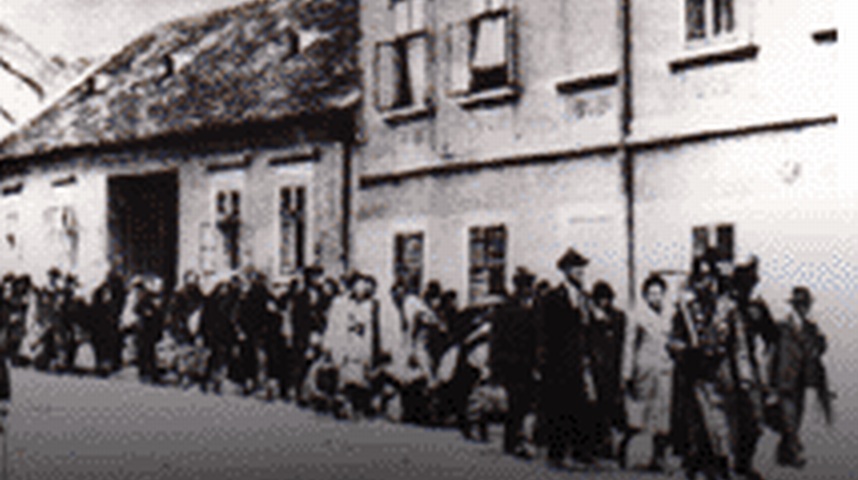 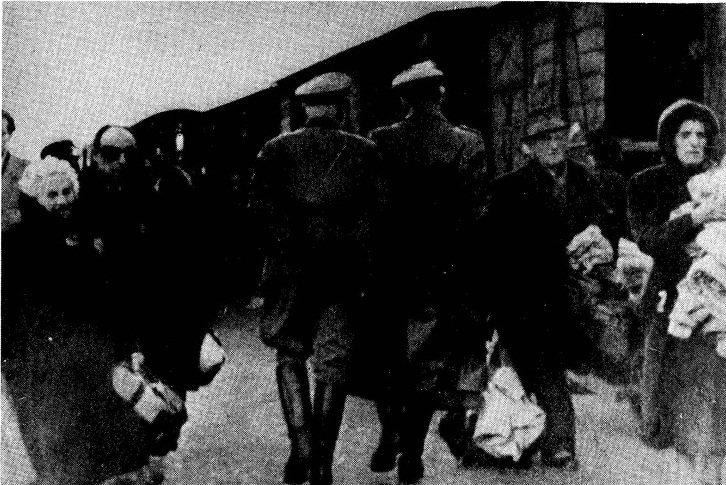
Between
March and June 1944 427,000 Hungarian Jews were
deported. In 46 working days nearly a quarter
of a million of them were exterminated.
|
In the United States, at the behest of President Roosevelt,
the War Refugee Board was established.
Its goal was to save Jews and other Nazi victims. The WRB
was well funded. Its top priority, after the partial Nazi
Hungarian occupation in June 1944, became the safety of
the 750,000 Hungarian Jews.
The War Refugee Board came to neutral Sweden, which had
an active embassy in Budapest, looking for someone who would
agree to go to Hungary. Such a person would work under the
auspices of the Swedish government with the protection of
a Swedish diplomatic passport, though representing and funded
by the War Refugee Board.
The War Refugee Board's representative in Hungary was to
be given a large sum of money and would be empowered by
the Swedish government to issue passports to as many Jews
as possible. Raoul Wallenberg was chosen to be the War Refugee
Board's representative.
On July 9, 1944, Raoul Wallenberg, age 31, arrived at the
Swedish embassy in Budapest. He traveled lightly with a
backpack and a small pistol. His primary adversary was SS
Lt. Col. Adolf Eichmann. By the time Wallenberg
arrived in Hungary, all 437,000 Jews - men, women, and children
- living outside Budapest had already been deported. The
rest of Hungary's Jewish community consisted of the 230,000
Jews living in the capital.
Wallenberg's
first job was redesigning the Swedish protective passport.
This new first secretary of the embassy found the document,
which was legal and could be issued only by the Swedish
legation, physically unimpressive. He knew that the Nazis
and their Hungarian counterparts were frequently people
of little education, who would be easily impressed by a
large, official looking document. How correct this simple
assessment proved to be!
Wallenberg redesigned the "Schutzpass."
He used the blue and yellow of the Swedish flag, and emblazoned
the document with the symbol of the triple crown of Sweden.
This passport saved the lives of tens of thousands of Jews,
as well as a great number of anti-Nazi Hungarian partisans.
According
to former staff member, Agnes Mandl Adachi,
Wallenberg printed huge placards and put them up all over
the city. The billboards, which pictured and proclaimed
the validity of the Schutzpass, were designed to make the
Nazis familiar with the document and its authority.
In the darkest days of 1944, the Swedish protective passport
even provided some humor in the midst of despair. Edith
Ernester, who lived through that time, recalls:
"It seemed so strange - this country of super-aryans,
the Swedes, taking us under their wings. Often, when an
Orthodox Jew went by, in his hat, beard and sidelocks, we'd
say, 'Look, there goes another Swede.'
A special department was created in the Swedish embassy
in Budapest with Wallenberg as its head. It was staffed
primarily with Jewish volunteers. Initially, there were
250 workers; later, he had about 400 people working around
the clock. Wallenberg seemed to sleep no more than an hour
or two a night, and then it was wherever he happened to
be working. He was everywhere.
Wallenberg persuaded the Hungarian authorities to free the
Jews on his staff from wearing the Yellow Star worn at all
times by other Jews. This simple exemption allowed his workers
much greater freedom of movement, as well as the protection
of anonymity - an essential factor in carrying out many
of Wallenberg's missions.

A
soup kitchen established by Wallenberg.
 
A
hospital established by Wallenberg. |
Agnes
Adachi recalls the night when she and her co-workers needed
to complete about 2,000 Schutzpasses and deliver them before
six a.m. when the Nazis would be rounding up several thousands
of Jewish women. She tells of working by candlelight in
a villa on the outskirts of Budapest. Wallenberg came in
and very calmly announced that the villa next door was the
Gestapo headquarters. He then smilingly assured his staff
that they must continue their work and not be alarmed. The
Schutzpasses were completed, and each was delivered on foot
before six a.m.
According to Mrs. Adachi: "He made a game out of outfoxing
the Nazis, but he played it with the utmost seriousness.
Most of all, he was like a big brother one looked up to,
and he had the most beautiful eyes that I have ever seen.
They were so beautiful and they saw everything."
Wallenberg's next step was crucial to ultimate success.
In a section of Budapest designated by the Hungarian government
as the "International Ghetto", Wallenberg purchased
thirty buildings where he flew Swedish flags next to the
Jewish Star. These buildings, and others for which he was
able to negotiate, were given the full protection of the
Swedish government.
In these protected houses, Wallenberg set up hospitals,
schools, soup kitchens, and a special shelter for 8,000
children whose parents had already been deported or killed.
Generally, the Swedish flag and the passports held by those
living in the houses were protection enough. If his spies
told him that a raid was being planned by the Nazis or their
Hungarian counterparts, young, blond Jewish men living in
the houses would be dressed in Nazi uniforms and put outside
to "guard" the houses.
Occasionally, however, all efforts failed. On Christmas
Day, 1944, a gang of Hungarian Nazis entered a protective
Swedish children's shelter and seventy-eight children were
machined gunned and beaten with rifle butts. All died.
Because of Wallenberg's swift action in setting up shelters
that offered care and protection, the other neutral legations
and the International Red Cross also followed and helped
greatly to expand the number of protected houses. After
the war it was established that about 50,000 Jews living
in the foreign houses of the International Ghetto had survived.
Of these, about 25,000 were directly under Wallenberg's
protection.
On
October 15, 1944, the legal Hungarian government of Admiral
Horthy fell and a pro-Nazi government called the
Arrow-Cross was installed. The Germans, who had previously
not been so much in evidence, came pouring across the Hungarian
border.
The Arrow-Cross gendarmes, an elite, quasi-military corps,
were Adolf Eichmann's greatest allies in his march toward
the "final solution". If possible, they were even
more sadistic than their German counterparts, and Eichmann
used their fervor accordingly.
In late 1944, with the Germans fighting on many fronts,
the end of the war and an Allied victory began to seem imminent.
This knowledge only seemed to spur Eichmann on to finish
his "purification" of Hungary.
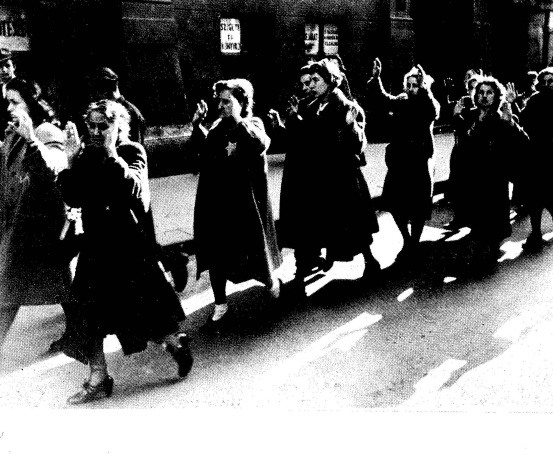
Women
being forced at gunpoint to join a death march. |
In
this situation, Jeno Levai recalls, "It
was of the utmost importance that the Nazis and the Arrow-Crossmen
were not able to ravage unhindered - they were compelled
to see that every step they took was being watched and followed
by the young Swedish diplomat. From Wallenberg they could
keep no secrets. The Arrow-Crossmen could not trick him.
They could not operate freely. They were held responsible
for the lives of the persecuted and the condemned. Wallenberg
was the 'world's observing eye', the one who continually
called the criminals to account.
As the Germans found themselves increasingly on the military
defensive, they were less able to supply Eichmann with trains
and trucks for deporting Jews from Hungary. On November
8, 1944, as the Russian army moved closer to Budapest, Eichmann
ordered all Jewish women and children rounded up and marched
on foot 125 miles to Hegyeshalom on the Austrian-Hungarian
border for deportation to the death camps. The men were
brought to a work camp in another location.
It took one week to walk in freezing cold and snow, with
no food or heavy clothing. Women in high heels, rounded
up in the street, children, and the elderly were forced
to keep up with the pace set by the gendarmes. All along
the route lay the dead and the dying.
Wallenberg, Per Anger, then second secretary
of the Swedish legation, and their driver went along the
route of the march by car, giving out food, clothing, fresh
water and Swedish protective passports whenever possible.
On the first day of the march, they rescued about 100 people
with the protective passports. A few others they rescued
by sheer bluff.

Jews
on foot being marched westward to the border and
deportation. |
In
the days that followed, Wallenberg made repeated trips along
the march route and continued his rescue efforts at the
border. He organized Red Cross truck convoys to deliver
food and set up checkpoints for those with "Schutzpasses".
About 1,500 people were thus rescued from transport to Auschwitz.
At the end of November, Eichmann was ordered back to Berlin
by Heinrich Himmler, who was preparing to put out peace
feelers to the Allies. The marches were halted and Eichmann
was instructed to cease all liquidation efforts.
In December 1944, Wallenberg reported to Stockholm about
the death marches. "It was possible to rescue some
2,000 persons from deportation for some reason or another."
He added, almost as an afterthought, that the Swedish mission
had also secured the return of 15,000 laborers holding Swedish
and other protective passes.
John Bierman, in his book on Wallenberg,
RIGHTEOUS GENTILE, has included a moving eye-witness account
of Wallenberg's work. They are the words of Tommy
Lapid, now director-general of the Israeli Broadcasting
Authority. In 1944 Lapid was 13 years old and one of 900
people crowded into a Swedish protected house. His father
was dead, and he had been allowed to remain with his mother.
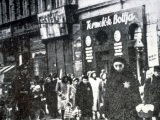
Jewish
women being marched through Budapest to a holding
cap, prior to deportation. This photograph was
taken by Wallenberg. |
"One morning, a group of Hungarian Fascists came into
the house and said that all the able-bodied women must go
with them. We knew what this meant. My mother kissed me
and I cried and she cried. We knew we were parting forever
and she left me there, an orphan to all intents and purposes.
Then two or three hours later, to my amazement, my mother
returned with the other women. It seemed like a mirage,
a miracle. My mother was there - she was alive and she was
hugging me and kissing me, and she said one word: Wallenberg."
"I knew whom she meant because Wallenberg was a legend
among the Jews. In the complete and total hell in which
we lived, there was a savior-angel somewhere, moving around."
Wallenberg became famous among the Jews of Hungary for his
many individual acts of bravery, but it was as a negotiator
that he achieved his greatest results. In addition to its
International Ghetto, Budapest had a general ghetto, which
was guarded and sealed off. The 70,000 Jews kept there as
virtual prisoners existed under the most horrible and primitive
conditions, unprotected from the violence of the Arrow-Crossmen.

Hungarian
gendarmes execute an 'uncooperative' Jewish leader. |
Wallenberg got word in the first days of January, 1945 that
a final plan, masterminded by Adolf Eichmann before he left
Hungary, was soon to be carried out. It was to be completed
very quickly, before the Russian army could enter Budapest
and open the ghetto. The plan called for the total massacre
of the ghetto population, by a combined task force of SS
men and Arrow-Crossmen led by a priest, Vilmas Lucska. An
additional 200 policemen would encircle the ghetto fence,
making certain that no Jews escaped.
All the documents for the extermination plan were ready
and the German commander in Budapest was prepared to carry
out his orders, even as the Russians shelled the city.
Wallenberg had been working behind the scenes for many months
with Pal Szalay, a high-ranking Arrow-Crossman
who was a senior police official. Szalay was horrified by
the atrocities committed by his compatriots, and he quickly
became an invaluable ally. In fact, he was the only prominent
member of the Arrow-Cross to escape execution after the
war by the People's Court; he was set free with no charges.
Szalay helped to save many lives in various incidents, but
his most important contribution was as Wallenberg's spokesman
in negotiations with the German general, August
Schmidthuber.
Schmidthuber was commander of the SS troops in Budapest,
and Eichmann had designated one of his detachments to spearhead
the ghetto action. It was far too dangerous for Wallenberg
to meet personally with the SS leader; he was already wanted
by the Gestapo, and there had been several attempts on his
life. Any direct communication with Schmidthuber would mark
Wallenberg as a dangerous international witness to the ghetto
extermination.
Wallenberg sent Pal Szalay to speak for him with the general.
Szalay informed Schmidthuber that, if the planned massacres
took place, Wallenberg would see to it that the general
was held personally responsible and would be hanged as a
war criminal. With the Russian army already approaching
the city, the general reconsidered. He issued the order
that no ghetto action was to take place. It was Wallenberg's
last victory.
When the Russian army entered Budapest, they found almost
70,000 Jewish men, women and children alive in the general
ghetto. Another 25,000 people were in the protected houses,
and an additional 25,000 persons of Jewish origin were found
hiding in Christian homes, monasteries, convents, church
basements, and other sanctuaries.
In all, 120,000 Jews of Budapest survived the "final
solution". They were the only substantial Jewish community
left in Europe. At least 100,000 of these people owed their
lives directly to Raoul Wallenberg.
In Jewish folklore there exists a tale of "36 righteous
men." This is the minimum number of anonymous, righteous
men who must be living in each generation, as the world
exists on their merit. These hidden saints appear in times
of great danger to the Jewish community, using their powers
to defeat its enemies. Perhaps such a legendary "Lamed-Vovnik,"
-or- "One of the Just" - made his appearance in
the person of Raoul Wallenberg.
The
Arrest and Disppearance of Raoul Wallenberg
On January 13, 1945 Wallenberg first contacted the Russians,
then on the outskirts of Budapest, in an effort to secure
food and supplies for the Jews under his protection.
On January 17 Wallenberg and his driver, Vilmos
Langfelder, left Budapest for a meeting with the
Russian commander, Marshal Malinovsky,
in the city of Debrecen, about 120 miles east of Budapest.
On the way to the meeting with the Soviet commander Wallenberg
and his driver were taken into "protective custody"
by the Soviet NKVD, the secret police later
known as the KGB.
The Soviet deputy foreign minister, Vladimir Dekanosov,
notified the Swedish Ambassador in Moscow that Wallenberg
was in Russian hands: "The Russian military authorities
have taken measures to protect Raoul Wallenberg and his
belongings," said the note.
When he was last seen on January 17 by members of his staff,
Wallenberg was already being "protected" by a
Russian officer and two soldiers on motorcycles. He was
carrying his knapsack, a briefcase containing his own post-war
plan, and a large sum of money. It was the last time anyone
ever saw Raoul Wallenberg as a free man.
In the first week of February 1945, after a trip by train
to Moscow, Wallenberg and his driver were placed in separate
cells in Lubianka Prison, the principal interrogation center
of the Soviet Secret Police.
That month Wallenberg's mother, Maj von Dardel,
was informed by the Russian ambassador to Sweden, that her
son was safe in Russia and would be back soon. The family
was asked not to make a major issue of Raoul's absence.
His safe return was assured.
On January 21, 1945, Wallenberg was placed in cell 123 of
Moscow's Lubianka Prison, where he joined Gustav
Richter, formerly a police attache at the German
embassy in Ruania. Richter testified in Sweden in 1955 that
Wallenberg was interrogated only once for about an hour
and one half, in the beginning of February 1945. He was
accused of spying, perhaps for the United States, since
the War Refugee Board was an American based and funded operation.
On March l, 1945, Gustav Richter was moved and his knowledge
of Wallenberg ended.
On March 8, 1945, the Soviet-controlled radio in Hungary
falsely reported that Wallenberg had been murdered in route
to Debrecen, probably by Hungarian Arrow-Cross or still
at large agents of the Gestapo.
In April 1945 Averell Harriman, then U.S.
ambassador to Moscow, was instructed to contact the Swedish
ambassador and offer any assistance necessary to help determine
Wallenberg's fate.
Swedish Ambassador Staffan Soderblom declined
U.S. help or involvement - potentially a major mistake.
A second tactical error was committed during a meeting between
Stalin and Soderblom on June 15, 1945. The ambassador told
the Soviet chief of state that he personally felt Wallenberg
was dead, killed by the Arrow-Cross, but would still appreciate
the Soviets' looking into the matter, as his government
in Stockholm had requested this inquiry. Stalin promised
to investigate personally and wrote Wallenberg's name on
a pad.
On August 8, 1947, the second important Soviet communique
about Wallenberg was sent to Sweden. Written by Foreign
Minister Andrei Vishinsky in reply to Swedish government
inquiries, the message stated that "a search of prisoner-of-war
camps and other establishments had turned up no trace of
Wallenberg. In short, 'Wallenberg is not in the Soviet Union
and is unknown to us'. The note concluded with the 'assumption'
that Wallenberg had either been killed in the battle for
Budapest or kidnapped and murdered by Nazis or Hungarian
Fascists"
For another ten years, the Vishinsky note was the only official
Russian word on Wallenberg's fate. When a group of Swedish
citizens nominated Wallenberg for the 1948 Nobel Prize for
Peace, it elicited the only public statement ever made by
the Soviet Union concerning Sweden and the Wallenberg affair:
A Soviet journal again accused the Nazis or the Arrow-Cross
of murdering Raoul Wallenberg.
For years thereafter, there was only official Soviet silence.
Then as a number of European prisoners were released in
1955, word of Wallenberg's imprisonment began to filter
back to Sweden.
On February 2, 1957, a note was delivered to the Swedish
government and signed by Deputy Foreign Minister
Andrei Gromyko. The note told of a handwritten
report by a Col. Smoltsov, head of Lubianka Prison's health
service, to Viktor Abakumov, minister of state security.
The report was supposedly written on July 17, 1947:
"I report that the prisoner Walenberg (sic) who is
well-known to you, died suddenly in his cell this night,
probably as a result of a heart attack. Pursuant to the
instructions given by you that I personally have Walenberg
under my care, I request approval to make an autopsy with
a view to establishing cause of death."
Scrawled across the bottom of the page in the same handwriting
was the addendum:
"I have personally notified the minister and it has
been ordered that the body be cremated without autopsy.
17, July. Smoltsov."
Smoltsov and Abakumov were both dead in 1957 when Gromyko
delivered the note. It is highly irregular for a Soviet
prison doctor to report directly to a minister rather than
to the head of the prison. The Russians never produced Col.
Smoltsov's note or even a photocopy of it - an important
omission, given the Russian's penchant for careful documentation.
Gromyko's communique ended by saying:
"The Soviet government presents its sincere regrets
for what has occurred and expresses its profound sympathy
to the Swedish Government as well as to Raoul's relatives."
On February 9, 1957, the Swedish ambassador to Moscow, Rolf
Sohlman, delivered a note to Gromyko from the Swedish government,
expressing outrage at the facts as reported in the Russian
communique. The note continued that the Swedish government
felt the investigation was incomplete. It also found it
difficult to believe that everything referring to Wallenberg
except the Smoltsov note had been completely obliterated.
The Swedish government then pressed the Soviets to continue
their investigation.
One final comment on the Gromyko letter and its continuing
effect on the fate of Raoul Wallenberg is made in an article
in the March, 1981 issue of McClean's Magazine. The author
is Yuri Luryi, an expert on Soviet law
who now lives and teaches in Canada:
"The sad thing is that it was Gromyko who signed the
letter back in 1957. He was simply a deputy of the foreign
minister then, but now he is a member of the Soviet Mount
Olympus. He is one of the gods who never makes mistakes.
One panelist in Sweden (Wallenberg Hearings, January, 1981)
said that until Gromyko is out of power, they do not expect
any positive change in the Soviet approach to Wallenberg's
fate."
July 1981
It has taken the world over 50 years to truly recognize
the greatness of Raoul Wallenberg - A man who acted while
others watched. The survivors of the Holocaust say "NEVER
AGAIN". Let us take these words and apply them further:
Let us apply them to those who have stood silently as Raoul
Wallenberg disappeared into the horrors of the Gulag. Raoul
Wallenberg is not only a symbol of injustice, but also a
symbol of indifference. Let us act now.
In
Acknowledgement
We are indebted to the following authors and publications:
WITH
RAOUL WALLENBERG IN BUDAPEST. Per Anger (Holocaust
Library).
RIGHTEOUS
GENTILE; THE STORY OF RAOUL WALLENBERG, MISSING HERO OF
THE HOLOCAUST, John Bierman (Viking Press, New
York. Allen Lane, London).
WALLENBERG,
THE MAN IN THE IRON WEB. Elenore Lester (Prentice
Hall).
RAOUL
WALLENBERG; HERO OF BUDAPEST. Eugene Levai (Central
European Publishing Company)
WALLENBERG.
Kati Marton (Random House)
RAOUL
WALLENBERG; ANGEL OF RESCUE. Harvey Rosenfeld
(Prometheus Books)
ON
THE 35YEAR OLD TRAIL OF A MISSING HERO. Yuri
Luryhi (McClean's Magazine)
THE
WALLENBERG MYSTERY-FIFTY FIVE YEARS LATER.
William Korey (The American Jewish Committee)
RAOUL
WALLENBERG-REPORT OF THE SWEDISH /RUSSIAN WORKING GROUP.
(Ministry For Foreign Affairs)
Click
here for a bibliography.
The
photographs taken in Budapest are the work of Thomas Veres,
Raoul Wallenberg's personal photographer. In order to escape
detection, many of the photographs were taken by Veres with
a camera hidden in his scarf. A tiny hole in the scarf provided
access for the camera lens. These secret photographs provide
a searing indictment of Nazi brutality.
Tom
Veres lived and worked as a photographer in New York. When
he died in 2002, the world lost a one of a kind individual
and the Committee lost a great friend.
|





